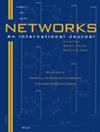An exact algorithm for the service network design problem with hub capacity constraints
IF 1.3
4区 计算机科学
Q4 COMPUTER SCIENCE, HARDWARE & ARCHITECTURE
引用次数: 2
Abstract
The service network design problem is commonly used to represent the tactical decisions encountered by a consolidation carrier operating a hub‐and‐spoke network: what transportation services to operate between hubs and how to route commodities from their origin to their destination through the network. In most settings, the capacity at hubs is not a limiting factor and can safely be ignored. However, in the context of city logistics networks, where space is limited and expensive, hub capacities typically have to be taken into account. The presence of hub capacity (and time) constraints implies that, contrary to traditional service network design problems, the existence of a feasible solution is no longer guaranteed. We present an exact dynamic discretization discovery algorithm for a variant of the service network design problem in which the number of vehicles that can be loaded and unloaded simultaneously at a hub is restricted. Novel techniques are introduced in the algorithm to handle the hub capacity constraints. A computational study using instances derived from real‐world data shows the potential of dynamic discretization discovery for this class of problems: integer program sizes are reduced by a factor of up to one thousand and small to mid size instances can be (optimally) solved in an acceptable amount of time.具有集线器容量约束的服务网络设计问题的精确算法
服务网络设计问题通常用于表示运营轮辐网络的整合运营商所遇到的战术决策:在枢纽之间运营什么运输服务,以及如何通过网络将商品从原产地运送到目的地。在大多数情况下,集线器的容量不是一个限制因素,可以安全地忽略。然而,在城市物流网络的背景下,空间有限且昂贵,通常必须考虑枢纽能力。集线器容量(和时间)限制的存在意味着,与传统的服务网络设计问题相反,不再保证存在可行的解决方案。针对服务网络设计问题的一个变体,我们提出了一种精确的动态离散化发现算法,在该问题中,可以在轮毂处同时装载和卸载的车辆数量受到限制。在算法中引入了新的技术来处理集线器容量约束。一项使用来自真实世界数据的实例的计算研究表明,动态离散化发现这类问题的潜力:整数程序大小最多可减少1000倍,中小型实例可以在可接受的时间内(最佳)解决。
本文章由计算机程序翻译,如有差异,请以英文原文为准。
求助全文
约1分钟内获得全文
求助全文
来源期刊

Networks
工程技术-计算机:硬件
CiteScore
4.40
自引率
9.50%
发文量
46
审稿时长
12 months
期刊介绍:
Network problems are pervasive in our modern technological society, as witnessed by our reliance on physical networks that provide power, communication, and transportation. As well, a number of processes can be modeled using logical networks, as in the scheduling of interdependent tasks, the dating of archaeological artifacts, or the compilation of subroutines comprising a large computer program. Networks provide a common framework for posing and studying problems that often have wider applicability than their originating context.
The goal of this journal is to provide a central forum for the distribution of timely information about network problems, their design and mathematical analysis, as well as efficient algorithms for carrying out optimization on networks. The nonstandard modeling of diverse processes using networks and network concepts is also of interest. Consequently, the disciplines that are useful in studying networks are varied, including applied mathematics, operations research, computer science, discrete mathematics, and economics.
Networks publishes material on the analytic modeling of problems using networks, the mathematical analysis of network problems, the design of computationally efficient network algorithms, and innovative case studies of successful network applications. We do not typically publish works that fall in the realm of pure graph theory (without significant algorithmic and modeling contributions) or papers that deal with engineering aspects of network design. Since the audience for this journal is then necessarily broad, articles that impact multiple application areas or that creatively use new or existing methodologies are especially appropriate. We seek to publish original, well-written research papers that make a substantive contribution to the knowledge base. In addition, tutorial and survey articles are welcomed. All manuscripts are carefully refereed.
 求助内容:
求助内容: 应助结果提醒方式:
应助结果提醒方式:


